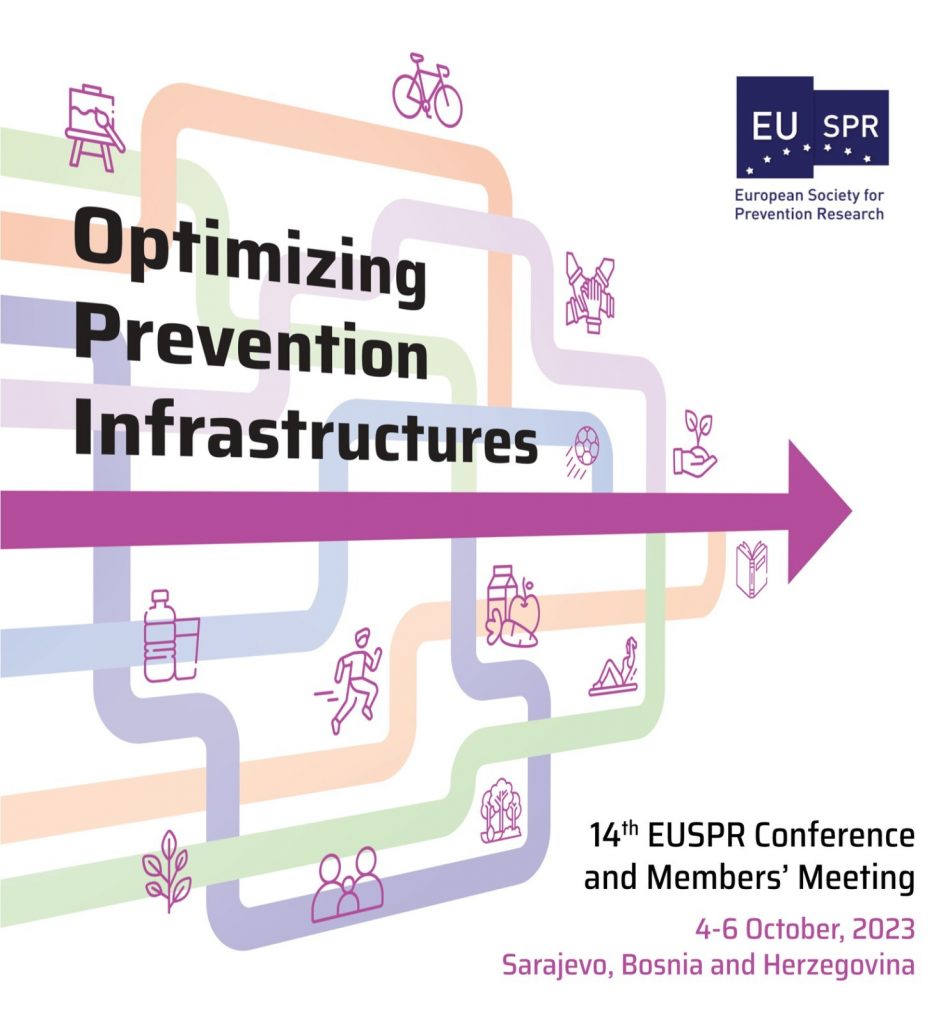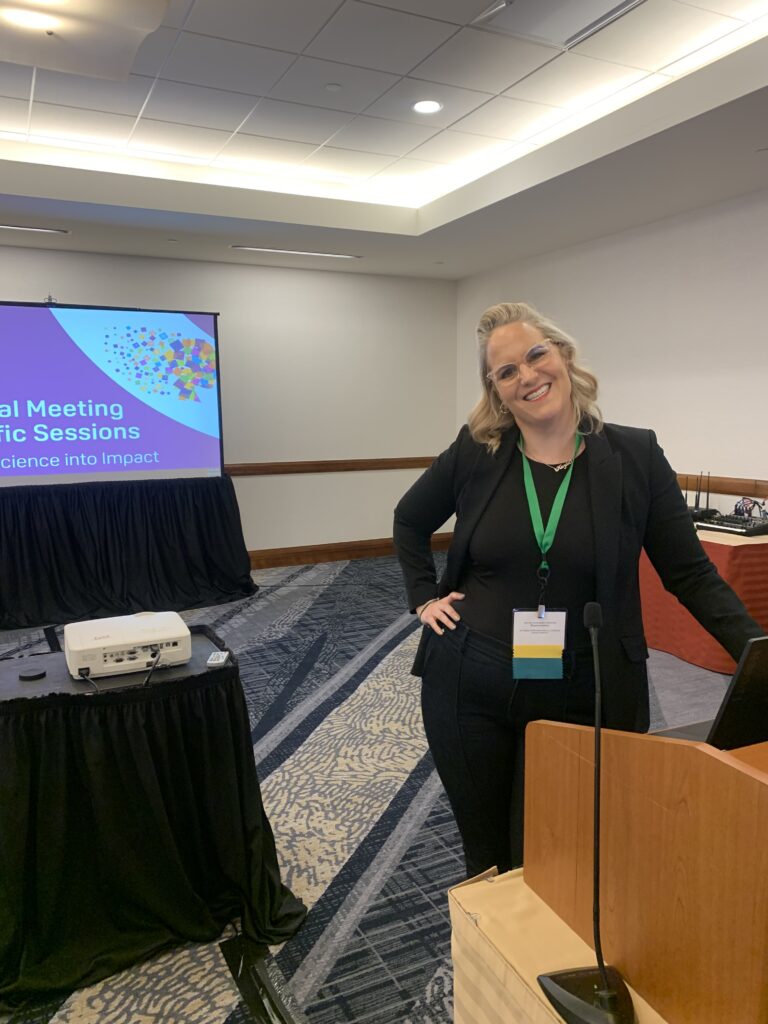KB Investigators Present at EUSPR
Three Klein Buendel Principal Investigators gave presentations on their recent or active research projects at the 14th European Society for Prevention Research Conference held October 4-6, 2023 in Sarajevo, Bosnia and Herzegovina. The presenters were Dr. David Buller, Director of Research, Dr. Barbara Walkosz, Senior Scientist, and Ms. Mary Buller, President. Each presentation complemented the conference theme of “Optimizing Prevention Infrastructures.” The prevention interventions were implemented in workplaces to reach their target populations directly and impactfully.
Presentation 1

“Formative Research on Professional Development Training to Maintain Responsible Beverage Service Practices”
Improved interventions are needed to reduce the negative consequences of alcohol intoxication. Responsible beverage service (RBS) training has been effective at reducing service to intoxicated customers in some cases. Its efficacy might be improved with an intervention that supports RBS techniques in the years between government-required RBS retraining. We conducted formative research to develop an ongoing professional development component for an online RBS training.
Formative research explored feasibility, acceptability, and content for an ongoing professional development intervention for alcohol servers. Semi-structured interviews were performed with owners/managers of licensed establishments (n=10) and focus groups (n=19) and survey (n=24) with alcohol servers in New Mexico and Washington. A prototype of a professional development component was produced, covering advanced RBS skills, support from experienced servers, professionalism, and basic management training, for delivery through social media. It was evaluated in a usability survey with alcohol servers (n=20) in California, New Mexico, and Washington.
While owners, managers, and alcohol servers were favorable toward RBS in their establishments, they endorsed the need for ongoing support for RBS for servers. Among topics of high interest were sharing tips, methods, and stories from experienced servers, balancing pressure to sell, navigating adult-use marijuana laws, dealing with children, recognizing intoxication, and managing difficult customers. The prototype was comprised of 50 social media posts, including text, infographics, videos, and interactive activity. Servers rated it as highly usable and appropriate for themselves and the establishment. Most servers (70%) were interested in receiving the ongoing information and activities.
Owners, managers, and servers believed that an ongoing professional development component on RBS would benefit servers and licensed establishments. Servers were interested in using such program. The professional development component has the potential to improve an existing RBS intervention.
Collaborators on this presentation included Dr. David Buller and Dr. W. Gill Woodall from Klein Buendel, and Dr. Robert Saltz from the Prevention Research Center at the Pacific Institute for Research and Evaluation in California. This research was supported by a grant from the National Institute on Alcohol Abuse and Alcoholism (AA029364; W. G. Woodall and D. Buller, MPIs).
Presentation 2

“Sun Safety Ink!: Sun Safety Practices of Tattoo Studio Clients”
Melanoma is the second most common cancer among young adults in the United States. Sunburn prevalence and low rates of sun protection are elevated in this group. Thus, efforts are needed to promote skin cancer prevention. An estimated 225 million people worldwide have tattoos with 40% of adults ages 18-29 with at least one tattoo, and at least 30% of American have tattooed skin. Sun Safety Ink! is a skin cancer prevention program targeted to clients of tattoo studios The goal of Sun Safety Ink! is to promote full-body comprehensive sun protection to clients of tattoo studios to compliment standard aftercare instructions that recommend sun protection for new tattoos.
Thirty-seven tattoo studios were enrolled in the Sun Safety Ink! program. At pretest, clients were recruited by tattoo artists to complete an online survey that assessed current self-reported sun protection (sunscreen, lip balm, hats, protective clothing, sunglasses, and shade), number of sunburns, and sunbed tanning frequency in the last year. Respondents were also asked to locate the position of tattoos on their body, using a drawing tool.
A total of 861 clients completed the online survey. Respondent demographics: age, average 31 yrs.; 67% female, 30% male; 60% white, 27% more than one race, 2% African American, 1% Asian and Native American, 13% Hispanic/Latino. The most prominent tattoo locations included: front left arm, 66%, front right arm, 58%, front upper torso, 52%, and back upper torso, 48%. Sun safety practices, that is, full body sun protection, (on a 5-point scale of “always” to “never”) were reported as: apply sunscreen SPF 15+ on face (aftershave, face lotion, or make-up), 3.31; apply sunscreen SPF 30+ on all exposed skin areas, 3.22; reapply sunscreen, 3.08; apply a lip balm, 3.28; wear any hat, 2.91; wear wide-brimmed hat, 2.21; wear sunglasses, 3.89; stay mostly in the shade, 3.38; and wear protective clothing, 2.91. Respondents also reported the number of sunburns as 1.53 and number of times indoor tanning as 1.11 in the last 12 months.
The pretest results indicate that full-body sun safety practices of tattooed adult can benefit from improvement, particularly wearing of hats and sun protective clothing. Further, knowledge of tattoo locations can direct sun safety recommendations to include protecting not only tattoos on arms and torsos but also non-tattooed skin on those areas of the body. Tattoo studies may be a viable location to delivering effective sun safety interventions to hard-to-reach tattooed, young adults.
Collaborators on this presentation included Dr. Barbara Walkosz, Ms. Mary Buller, and Dr. David Buller from Klein Buendel, and Dr. Robert Dellavalle from the University of Colorado School of Medicine and the Department of Veteran Affairs. This research was supported by a grant (CA206569; B. Walkosz, PI) from the National Cancer Institute.
Presentation 3

“Protection from Solar Radiation in the Era of Climate Change: Preventing Heat Illness and Skin Cancer for Outdoor Workers”
The sun’s energy is both a necessity and a threat to humans. Extreme heat linked to climate change and unprotected exposure to ultraviolet radiation (UV) make people who work outdoors vulnerable to life-threatening heat illness and skin cancer. It is estimated that infrared radiation (heat) and UV contributed to over 120,000 deaths from skin cancer in 2020 and over 350,000 deaths from excessive heat in 2019. Efforts to protect workers from heat or UV can work in tandem to help outdoor workers adapt to the warming world.
Workplace interviews, a review of literature, and expert consultants helped expand an existing intervention for U.S. occupational skin cancer prevention to include heat illness prevention, and to be delivered online. Content consultants include safety training professionals, behavioral scientists, and dermatologists. The program, Go Sun Smart at Work (GSSW), will be evaluated in 2024 in a randomized controlled trial enrolling 20 U.S. employers.
GSSW is an innovative virtual learning environment and resource hub promoting comprehensive solar radiation policy, training, and personal protection for outdoor workers. It includes (1) a manager resource hub that guides decision-makers through implementation strategies using a structured conversation agent; (2) an employee sun safety training video that is compliant with eLearning standards and compatible with learning management systems for monitoring; and (3) a trove of resources and downloadable materials addressing heat illness and skin cancer prevention. The structured conversational agent adjusts workplace implementation strategies for management’s readiness to innovate on sun safety based on Diffusion of Innovations Theory.
GSSW will help outdoor workers protect themselves from the serious threats of climate change by providing employers with a convenient, comprehensive solar radiation safety policy and training program. It will support the shift to online training to improve accessibility, fidelity, adherence, and tracking, while saving resources.
Collaborators on this presentation included Ms. Mary Buller, Dr. Barbara Walkosz, Ms. Julia Berteletti, Mr. Brandon Herbeck, Ms. Irene Adjei, and Dr. David Buller from Klein Buendel. This research was supported by a grant (CA257778; M. Buller, PI) from the National Cancer Institute.















